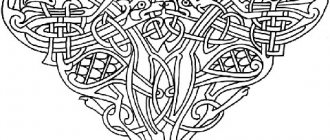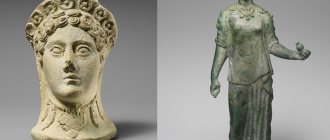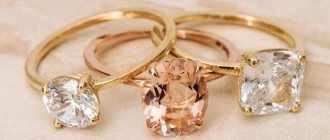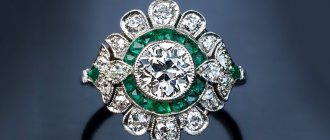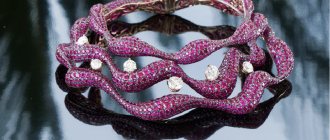At the beginning of the 20th century, around the 20s, society gradually abandoned the outgoing Art Nouveau style with its twisted lines and faded color. Late Art Nouveau, called “modern,” pleased with the strengthening of geometricism. Instead of fairy wings, jewelers began to depict airplane wings. The search for style was interrupted for two years by the First World War, but the period between the two world wars belongs entirely to the Art Deco style. Those who want to get acquainted with this style can watch the film “The Great Gatsby”.
In the 1920s, the “garçon” fashion appeared, when fashionable Parisian women cut their hair short, shortened their skirts, and abandoned sleeves. Instead of a luxurious evening “brooch-tassel,” during the day they wore artificial pearls in the form of an endless thread or beads made of stones. Heavy belts and bracelets on the wrists and forearms came into fashion. A novelty was a two-part brooch, secured with a clip lock, which was used to pin fashionable short coats with three-quarter sleeves - “troucars”.
Wristwatches, which replaced the usual version on a chain at this time, began to come into use and created a real sensation. They were produced in a variety of shapes and were richly and elegantly decorated.
Thus, the Art Deco style arose in France and then established itself throughout Europe and the United States (the spelling of Art Deco in the Russian version is not entirely correct, since in Art Deco the letter t is not readable).
History of Art Deco Jewelry
In 1925, the International Exhibition of Modern Decorative and Industrial Arts (Exposition Internationale des Arts Décoratifs et Industriels Modernes) was held in Paris. Its abbreviated name Arts Décoratifs (“decorative arts”) decreased in use among event participants and press representatives even more, to Art Deco. The word “Art Deco” became the name of the leading movement in architecture, painting, clothing and jewelry design, which ruled the show in the Old and New Worlds in the 1920s and 1930s, between the First and Second World Wars.
Art Deco is a holiday style. Bright, luxurious and eclectic, that is, connecting disparate elements. It has a place for strict geometry and ethnic ornaments, animal and plant motifs and the achievements of science, technology, industry of those years, “quotes” from ancient classics and seething modernity, in love with jazz and raising the banner of women's emancipation.
Tamara de Lempicka. Portrait of Madame Beaucard (1931)
Art Deco. One hundred years at the height of fashion
Art Deco jewelry is about geometry and bright, colored stones. And also China, Japan, India, Egypt and other exotics - as the main motives.
Marina Volkova
At the International Exhibition of Decorative and Industrial Arts in Paris, Van Cleef & Arpels was awarded the Grand Prix for its Roses bracelet, set with rubies, emeralds and diamonds. 1925 Photo: Van Cleef & Arpels
In 1925, the International Exhibition of Decorative Arts took place in Paris, which is considered to be the starting point of a new style, Art Deco. The exhibition also featured jewelry that became a symbol of a new wave in jewelry art. Art Deco replaced Art Nouveau (or Art Nouveau, as this style was called in Russia) and “contradicted” it in everything. If Art Nouveau is about whimsical, sinuous lines associated with the blow of a whip, then Art Deco, on the contrary, is about strict lines and geometry of forms. Art Nouveau jewelry was thin and elegant, while Art Deco jewelry was large and massive. The first ones glorified nature and were distinguished by plant motifs, the second ones were dedicated to dynamics, industry, and the world of high speeds. With a number of changes in motifs and materials, this style lasted until the outbreak of World War II.
Boucheron. Art Deco brooch designed by Lucien Hirtz. 1925. Photo: FD Gallery / TEFAF Maastricht 2020
Vendôme houses
Jewelry in the Art Deco was produced by both large jewelry houses and independent jewelry artists, whose names are also inscribed in history. The main brands associated with the Art Deco jewelry style are the so-called Vendôme houses (large firms with headquarters on Place Vendôme in Paris): Cartier, Boucheron, Van Cleef & Arpels and a number of others. They quickly picked up the fashion for geometric, symmetrical, bright jewelry. Their jewelry used carved rubies and emeralds. They were set in platinum or its cheaper analogue, the platinum alloy, which with its matte whiteness perfectly set off colored stones. The compositions of decorations were built on the principle of geometric figures and, with their strict balance, resembled the outlines of skyscrapers, which became the main architectural sign of the era.
Cecil Beaton. Portrait of Daisy Fellows, a columnist for the Parisian Harper's Bazaar, one of the most fashionable women of pre-war Paris. 1936. Photo: Courtesy of the Cecil Beaton studio archive at Sotheby's
Roaring Twenties and After
Images of Art Deco jewelry are often linked to the fashion of those years, when long dresses with complex cuts and broken, pretentious silhouettes were replaced by laconic, loose outfits that impressed not with the abundance of details, but with the beauty of the decor (for example, bugle embroidery). They demanded similar decorations, because the previous ones, as intricate as the outfits, categorically did not suit them. The most sought-after jewelry of the era were long necklaces, sautoirs, which were often worn backwards, emphasizing the beautiful, deep neckline on the back and jewelry watches, because the ladies of the new era closely monitored the time. Suit accessories, which simultaneously became works of jewelry, were also in great demand: cigarette cases and women's handbags for cosmetics, an analogue of modern clutches.
Cartier lacquered box. Paris, 1927. Photo: Schmuckmuseum Pforzheim
Exotic motives
Art Deco style was inspired by various motives. The era was partial to the exotic: China, Japan, Indian art, African motifs, even distant Latin America. Jewelry designers used techniques typical for the decoration of those regions (for example, varnishes, common in China, and carved stones, as in native Indian products). “Overseas” materials also came into fashion: jade, lapis lazuli, bone inserts and mother-of-pearl mosaics. The decorations were stylized as Egyptian, Chinese and Indian, but, of course, with a large degree of convention. Images of deities from Egyptian papyri were laid out with rubies, sapphires and emeralds against a background of sparkling colorless diamonds - as in the famous series of pro-Egyptian jewelry by Van Cleef & Arpels of the 1920s. The fashion for Egypt was set by the legendary discovery of Tutankhamun's tomb in 1922. Just like three years later - African sketches on the Parisian stage, sensationally presented in the press, and excavations in Latin America dating back to the same decade.
Van Cleef&Arpels. Egyptian bracelet. 1923. Photo: Van Cleef&Arpels
Art Deco gave birth to the famous Tutti Frutti style of the house of Cartier, one of the brand's signature trends. “Tutti-frutti” is a colloquial name that these decorations received due to the fact that they very much resembled a scattering of candies on the counter. Meanwhile, each such “lollipop” is a carved precious stone, and the decoration itself refers to the traditions of the great Mughals, the fabulously wealthy Indian rulers who, without exaggeration, owned luxurious jewelry. Their name has become a household name.
Cartier. Tutti Frutti bracelet. Photo: Sotheby's
Independent names
Along with the large Art Deco firms, independent jewelers also worked. The most famous of them are Jean and Georges Fouquet and Gerard Sandoz. Their decorations were uncompromising. If the big houses always had commercial success in mind, these craftsmen created innovative jewelry without fear of not selling it. Therefore, they look very avant-garde.
see also
Story
10 jewelry masterpieces of the Louvre
Georges Fouquet. Dress Ornament brooch from the collection of the Metropolitan Museum of Art. 1923. Jadeite, onyx, diamonds, platinum, enamel. Photo: © 2022 Artists Rights Society (ARS), New York
They were often inspired by the artistic experiments of the era. For example, they tried to transfer the principles of cubism to jewelry art. Thus, Jean Fouquet loved large, massive bracelets and could use materials that were strange for the jewelry art of those years, such as steel. Sandoz, on the other hand, preferred to work with semi-precious stones like labradorite and loved to combine gold with... hematite (generally unknown to few people at that time). Jean's father Georges Fouquet also created jewelry, but his designs were more reminiscent of items from large companies and were more familiar to the public. However, it was Georges (who had previously worked a lot in the Art Nouveau style, including in collaboration with Alphonse Mucha) who discovered for jewelry the beauty of details made of transparent rock crystal, black onyx and such “simple”, as at first considered, materials like turquoise and lapis lazuli.
Gerard Sandoz. Cigarette case. Paris, 1929. Photo: Victoria & Albert Museum
Was Art Deco or its followers in Russia?
In Russia, the 1920s and 30s were marked by civil war and the difficult formation of a new state. The industry was faced with tasks of prime necessity, and, of course, the production of luxury goods was not included in them. Large jewelry houses ceased to exist, their property was nationalized and sold off. Small workshops began to unite into workers' artels and carry out mass orders that were far from high art.
However, subsequently the Art Deco style, which was not in demand at the time, was turned to more than once. Large Soviet jewelry factories already produced retrospective collections with Art Deco motifs in the 1960s and 70s. Instead of platinum, silver was used, diamonds were replaced with semi-precious stones. But we can remember that these materials were also used then, and as some kind of exotic, novelty.
Milio. Bracelet from the Art Deco collection. Photo: Milio
This style reached its true flowering in the post-perestroika era, when the desire for luxury again ceased to be something shameful. Modern jewelers also often turn to the Art Deco style, because it perfectly rhymes with precious stones and eye-catching color combinations. Chamovskikh , Ringo, Maxim Demidov and Milio (a whole line of Art Deco jewelry ) is built on geometry and large stones of the big four (diamonds, emeralds, rubies, sapphires) The high jewelry brand Ichien prides itself on jewelry in the Art Deco style and with stones characteristic of those jewelry: lapis lazuli, onyx, coral. The brand has such a popular genre in that era as jewelry cufflinks. And the Kabarovsky brand offers both spectacular women's jewelry in this style and interesting, designer collections of men's jewelry with Art Deco motifs.
Main features of Art Deco jewelry style
Materials and decoration techniques. The iconic metal of the Art Deco era was platinum, which was brought into fashion by the house of Cartier in the 1910s. Thanks to this, white gold, silver, steel and even aluminum, similar in shade, have gained popularity. Jewelers also used exotic materials - ivory, crocodile skin, shark, zebra, and rare woods. The merit of Art Deco is the bold and effective combination of precious stones with semi-precious ones, diamonds with rhinestones, and natural pearls with artificial ones in one piece of jewelry. As for the technique of decorating jewelry, perhaps the most common jewelry techniques of those years were enameling of metals, unusual cutting and inlaying of stones.
Forms of decorations. Art Deco cultivates the shape and color palette of decoration, admires its design, so geometricity and strict symmetry come to the fore, and the arrangement of decoration elements is subject to a certain rhythm of alternation.
Leading motifs in jewelry design. Images, scenery and costumes of Russian ballet (Sergei Diaghilev’s ballet enterprise “Russian Seasons” made Europe fall in love with the art of dance again). Culture of different countries, continents and eras: Ancient Egypt (interest was fueled by the discovery of Tutankhamun’s tomb in 1922), China, Japan, India, Ancient Greece, Africa. Geometric motifs. Objects of flora and fauna.
Typical decorations . Headband (bandeau), inlaid with rhinestones, pearls or diamonds; cocktail ring; collar necklace; garland necklace; snake necklace and bracelet; ring and bracelet in the shape of a panther; brooch, pendant, earrings in the form of long tassels; a long string of natural or artificial pearls (remember Coco Chanel!); sautoir - a long chain with large stones or pendants, which was worn over the shoulder, in a cutout on the back, or put in several folds on the hand; brooch in the form of a basket with flowers and fruits; wide flat openwork bracelet; large pendant; wristwatch with rich, sophisticated decor.
Art Deco era and jewelry technology
Alfred Van Cleef and Julien Arpels invented an invisible setting for gemstones in 1935. Grooves were cut into rubies, sapphires and diamonds, the stones fit closely to each other, the metal was completely covered. Thanks to this new product, and after it, others began to create real masterpieces in the Art Deco style.
By the 1930s, Art Deco jewelry had become widespread as both European countries and America began to create items that were accessible to a wide range of buyers. These were clip brooches made of diamonds, sautoirs (from the French “porter en sautoire” - to wear over the shoulder) and bracelets, where small diamonds emphasized the ornamental lines of clear flat patterns. You can still find many similar jewelry in antique stores today.
Throughout the world, the period of dominance of the Art Deco style lasted between the First and Second World Wars. But his figurative structure and the techniques used turned out to be so universal that they still look bright and modern to this day.
(Visited 1,206 times, 1 visits today)
Style as part of... style
Jewelry and costume jewelry in the Art Deco style are much less pretentious and capricious in combination with clothing than jewelry in the Baroque style. If you are looking for accessories that are bright, interesting, but elegant (for example, for a New Year's party), opt for an Art Deco bracelet, ring or earrings.
But also everyday clothes: white T-shirts, plain knitted dresses and cardigans – go harmoniously with geometric chandelier earrings, a multi-tiered chain, a beetle brooch or a large ring. The main thing is not to overload your daytime look and choose a single “jazz” jewelry addition to it.
Style in jewelry
Van Cleef and Arpels brooch. 1930
Van Cleef and Arpels collar necklace. 1929
Egyptian style brooch Van Cleef and Arpels. 1924
The companies Cartier and Van Cleef & Arpels, as well as other jewelry houses, deliberately worked according to the principles of Art Deco in their works. After the fluid forms and poetic flowers of the Art Nouveau era (aka Art Nouveau), their jewelry seemed flashy and shocking.
Art Deco jewelry on the catwalk
The fall-winter 2016/2017 collections feature many references to the Art Deco era in accessories. Thus, rivers of artificial pearls “flow” at the shows of Chanel, Moschino (this fashion brand has rows of white beads even on the ankles of models!) and Gucci.
Hyperbolic tassel earrings are the main decoration of this winter according to Dsquared2, but at Anthony Vaccarello the trendy accessory is modernized only by the fact that the earring with rhinestones is unpaired. Saint Laurent makes a pair of these earrings part of a vamp look.
At Valentino, the breath of technocracy touched the design of earrings - in the 1920s, such jewelry would have been called skyscraper earrings for their length and would have been approved of their similarity to the forged parts of some mechanism.
Dsquared2, autumn-winter 2016/2017
Gucci, autumn-winter 2016/2017
Chanel, autumn-winter 2016/2017
Valentino, autumn-winter 2016/2017
Art Deco jewelry on the red carpet
Looking back at the celebratory events of 2016, we note that jewelry in the Art Deco style is a frequent choice for publication. Thus, the De Grisogono fan-shaped diamond earrings are worthy of praise - Ashley Greene wore them on September 3 at the premiere of the drama “And We Lost the Battle” at the Venice Film Festival. At the opening of the same festival and the premiere of the romantic comedy “La La Land” on August 31, model Bianca Balti appeared in an unusual black trench dress, complementing it with a Chopard collar necklace with diamonds and an emerald pendant.
Ashley Greene at De Grisogono, Venice 2016
Bianca Balti in Chopard, Venice 2016
For another film festival, Cannes, Art Deco decorations became a leading trend. At the premiere of the drama “The Last Face” on May 20, Charlize Theron liked a necklace in the shape of a snake from Cartier, and Alessandra Ambrosio tamed a precious reptile from Bulgari. The amfAR gala charity evening, held on May 19 as part of the festival, featured luxurious diamond Art Deco sets by Rosie Huntington-Whiteley (Chanel), Alessandra Ambrosio (Boucheron), Karlie Kloss (Chopard), Bella Hadid (De Grisogono) and Liu Wen ( Boucheron).
Alessandra Ambrosio at Bulgari, Cannes 2016
Karlie Kloss in Chopard, Cannes 2016
Rosie Huntington-Whiteley in Chanel, Cannes 2016
In conclusion, let's take a look at the main red carpet of the year - the Oscar ceremony, which took place on February 28. Her best Art Deco jewels include Charlize Theron's platinum pendant necklace from Harry Winston, Cate Blanchett's diamond stud earrings from Tiffany & Co., Olivia Munn's Forevemark snake bracelet and a Bulgari floral necklace chosen by Naomi Watts .
Cate Blanchett at Tiffany & Co, Oscar 2016
Charlize Theron in Harry Winston, Oscar 2016
Naomi Watts at Bulgari, Oscar 2016
